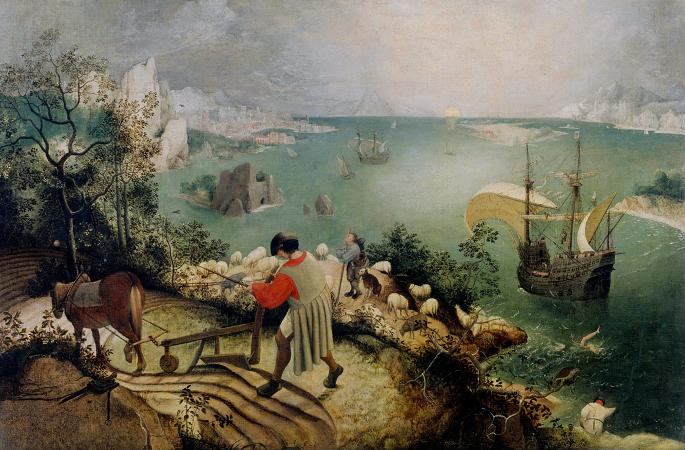Landscape with Fall of Icarus (c1558). Oil on canvas on panel. 74 x 112. Landscape with the Fall of Icarus is a painting in oil on canvas measuring 73.5 by 112 centimetres in the Royal Museums of Fine Arts of Belgium in Brussels. It was long thought to be by the leading painter of Dutch and Flemish Renaissance painting, Pieter Bruegel the Elder. However, following technical examinations in 1996 of the painting hanging in the Brussels museum, that attribution is regarded as very doubtful, and the painting, perhaps painted in the 1560s, is now usually seen as a good early copy by an unknown artist of Bruegel's lost original, perhaps from about 1558. According to the museum: It is doubtful the execution is by Bruegel the Elder, but the composition can be said with certainty to be his, although recent technical research has re-opened the question. Largely derived from Ovid, the painting is described in W. H. Auden's famous poem Musée des Beaux-Arts, named after the museum in Brussels which holds the painting, and became the subject of a poem of the same name by William Carlos Williams, as well as Lines on Bruegel's 'Icarus' by Michael Hamburger. In Greek mythology, Icarus succeeded in flying, with wings made by his father Daedalus, using feathers secured with bees wax. Ignoring his father's warnings, Icarus chose to fly too close to the sun, melting the wax, and fell into the sea and drowned. His legs can be seen in the water just below the ship. The sun, already half-set on the horizon, is a long way away; the flight did not reach anywhere near it. Daedalus does not appear in this version of the painting, though he does, still flying, in the van Buuren one. The ploughman, shepherd and angler are mentioned in Ovid's account of the legend; they are: astonished and think to see gods approaching them through the aether, which is not entirely the impression given in the painting. The shepherd gazing into the air, away from the ship, may be explained by another version of the composition; in the original work there was probably also a figure of Daedalus in the sky to the left, at which he stares. There is also a Flemish proverb: And the farmer continued to plough. pointing out the ignorance of people to fellow men's suffering. The painting may, as Auden's poem suggests, depict humankind's indifference to suffering by highlighting the ordinary events which continue to occur, despite the unobserved death of Icarus. Though the world landscape, a type of work with the title subject represented by small figures in the distance, was an established type in Early Netherlandish painting, pioneered by Joachim Patiner, to have a much larger unrelated genre figure in the foreground is original and represents something of a blow against the emerging hierarchy of genres. Other landscapes by Bruegel, for example The Hunters in the Snow and others in that series of paintings showing the seasons, show genre figures in a raised foreground, but not so large relative to the size of the image, nor with a subject from a higher class of painting in the background. However, paintings from the same period by the Antwerp artist Pieter Aertsen had large kitchen or market genre scenes, with large figures in the foreground, and in the distant background a glimpse of a scene from the Life of Christ. Giving more prominence to low subject-matter than high in the same work is a feature of some Northern Mannerist art, often called Mannerist inversion. The traditional moral of the Icarus story, warning against excessive ambition, is reinforced by fore-grounding humbler figures who appear content to fill useful agricultural roles in life. The painting is probably a version of a lost original by Bruegel. A date of c. 1558 has been suggested for the lost original, based on Bruegel's other works; the copy probably comes from the 1560s or soon after. It is in oils whereas Bruegel's other paintings on canvas are in tempera. The work was unknown until it was bought by the museum in 1912; subsequently another version on panel, generally considered inferior, turned up, which was acquired in 1953 by Daniel van Buuren for his private house, today a museum in Brussels. In this, which excludes the far left and right sides of the composition, Icarus is in the water but Daedelus is still in the air, and the shepherd's gaze is directed at him, explaining one aspect of the composition of the other version. The original would have been Bruegel's only known painting of a mythological subject. The perspective of the ship and figures is not entirely consistent, although this may enhance the power of the composition. Bruegel also produced a design for an engraving with the ship and the two falling figures.
more...





